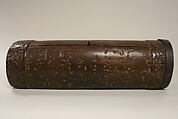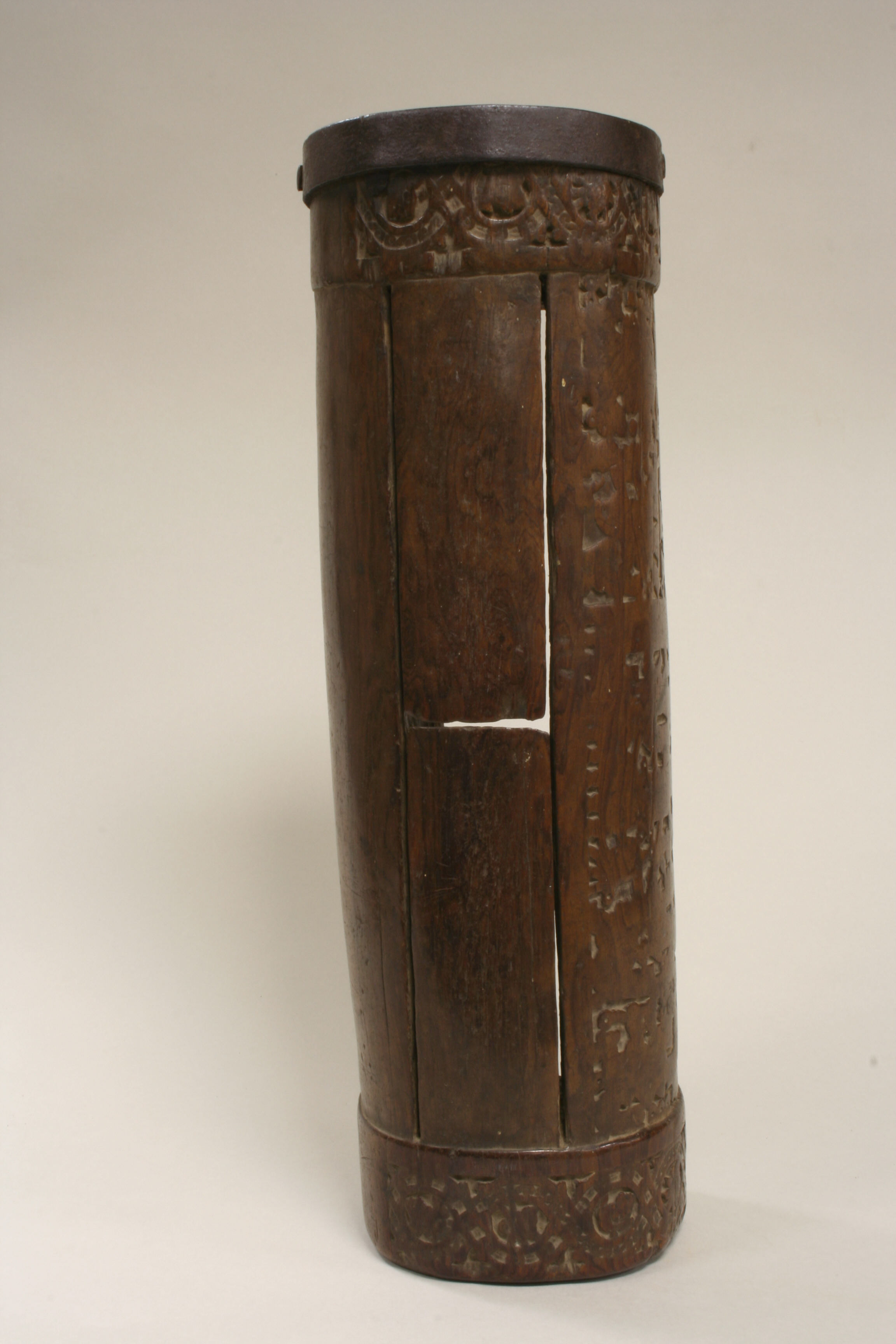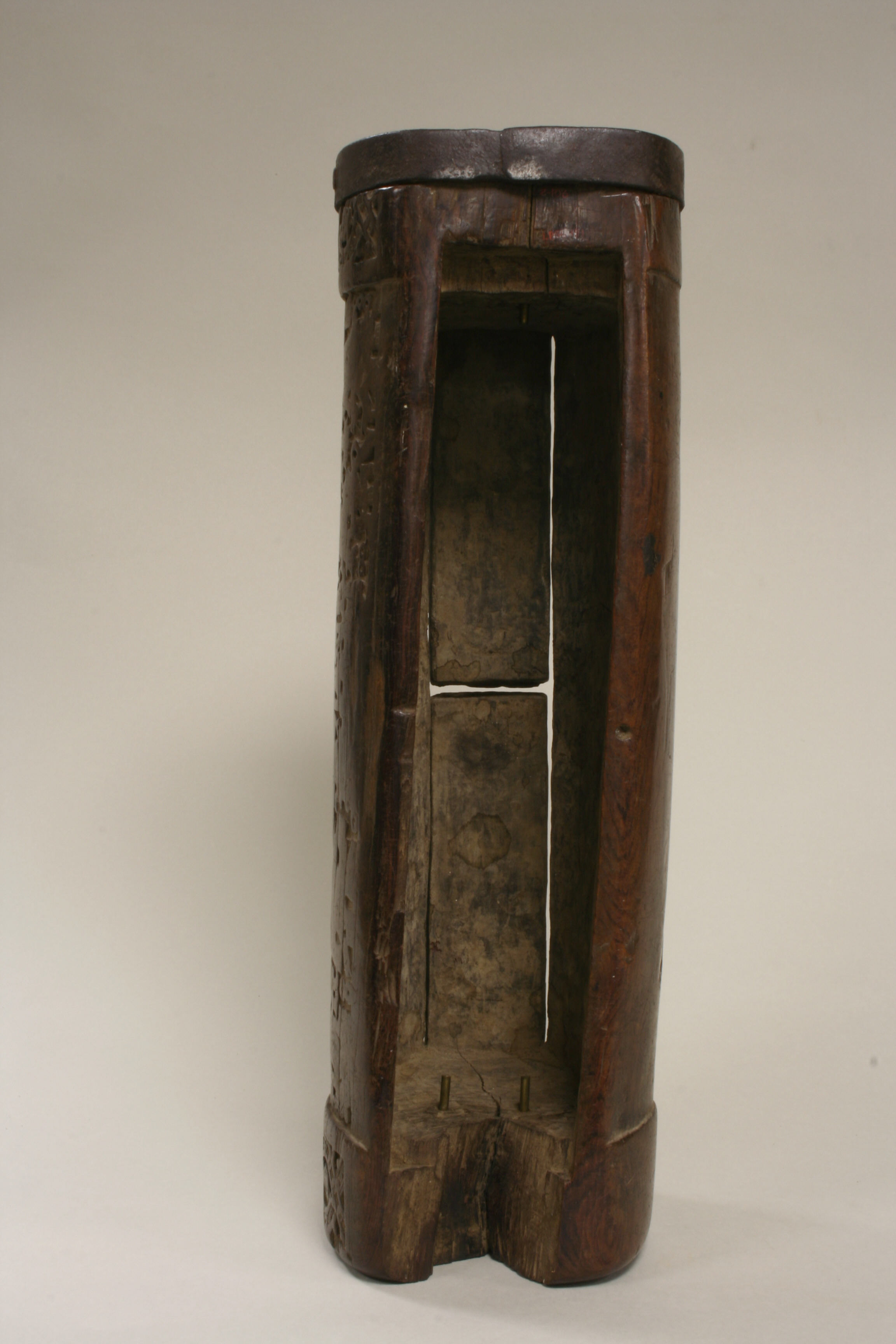Drum (Teponaztli)
Positioned just as perfectly as part of an elegant wedding ensemble at the house of a noble family as it would have been in a grand military procession, a community-wide agricultural dance in Tenochtitlan (the ruins of which lie underneath what is now the center of modern-day Mexico City), or a rough-and-tumble sporting event at the Great Ballcourt, study of this horizontal drum reveals a succession of cultural layers, from its initial creation by a Mexica (Aztec) artist to its continued use in the colonial period (Bravo, 2018, p. 42; Castañeda and Mendoza, 1933, p. 16; Kurath and Martí, 1964, p. 47, 60, 84). Known as a teponaztli, such drums were essential to religious, military, and especially royal ceremonies.
We apply the term “Aztec,” a Western portmanteau meaning “people of Aztlan” (a mythical homeland), to a number of Nahuatl-speaking groups which were united under the rulership of the Mexica, a late-arriving but ultimately powerful group in the Valley of Mexico. This drum, likely made of extremely dense rosewood, is one of two primary types of percussion instruments in Mexica culture and consistent with those of the broader, Nahuatl-speaking world. The present teponaztli was hollowed out underneath so as to create room for the reverberations which produce its sound. Two keys or “tongues” on the top were hollowed out to different degrees in order to produce two distinct tones. Played by striking mallets on its long side, laid out horizontally on one’s lap or on a small stand (Both, 2010, p. 16), the instrument is distinct from the larger huehuetl drum, which is played by standing the object up on one of its small faces and drumming on the opposite face. Whereas the huehuetl is larger and more stationary in use, the teponaztli is quite mobile, albeit very heavy.
The cylindrical shape of this drum is fairly normative in the context of the larger corpus—some teponaztli were created in the shapes of animals. The artist added low-relief carvings onto only one side of our drum, suggesting that it was likely played with that face outward. Although very worn—evidence of substantial use—traces of depictions of flora and fauna can be seen, including rabbits, birds, and other animals. Further study may illuminate specific meanings of the imagery, including the possibility that some of the motifs refer to specific historic dates.
Its slight size belying the breadth of its capabilities, such a teponaztli would have been played using wooden mallets with rubber tips, called olmaiti (literally “rubber hands”), with the instrument sitting on one’s lap, or perhaps mounted on a simple, x-shaped stand or a more elaborate, ceremonial throne. Later iterations of teponaztli may have had more than two keys (Stevenson, 1976, p. 66). Though scholars do not agree on the gender of drummers, it is likely that both men and women in Mexica communities played the teponaztli (Kurath and Martí, p. 84). Other teponaztli are in the collections of the Museo Nacional de Antropología, Mexico City (including the “Tlaxcala Teponaztli” and the “Malinalco Teponaztli”); the Museo de Antropología e História, Toluca; the British Museum, London; and the American Museum of Natural History, New York. The British Museum examples include imagery of captives with turtle armbands, a horned owl (tecolotl), battle scenes with males and females, a warrior named “Five Rain,” and a glyph indicating a specific date in history.
Teponaztli were believed to be the manifestation of a court singer kidnapped by the god Tezcatlipoca and sent back to Earth in object form. As teponaztli were played, the powerful sound made manifest supernatural forces. Sixteenth-century Spanish accounts and contemporaneous codices (indigenous illustrated manuscripts) describe the contexts in which teponaztli were played, including tozohualiztli (priestly midnight household ceremonies) (Both, 2010, p. 20); xochicuicame (annual flower poetry songs) (Kurath and Martí, p. 47; Schultze and Kutscher 1957, p. 47-57); royal or imperial funerals (Casteñeda and Mendoza, 1933, p. 13; Stevenson, 1976, p. 68-69), and even wartime communication (Stevenson, 1976, p. 71). Stevenson (1976, p. 69) reports that sacrificial victims would have been slung over the drum, their hearts cut out with an obsidian knife, their blood seeping through the keys to the interior to ritually refresh the instrument. Along with the other components of ritual performance, including other instruments, costumes, and dance, teponaztli were part of a dazzling display of metaphysical theater and power.
One end of this drum is encircled by an iron band. This was likely added during colonial times (iron was introduced to the New World by the Spanish) to prevent the further expansion and splitting of the wood. Spanish priests often choreographed syncretic indigenous/European public celebrations and worship; the teponaztli would have been a means to integrate Mexica traditions into Christian doctrine and New Spanish society. These latterly-applied materials are likely evidence of that syncretism, and this drum may have been used in colonial times to link the indigenous past to a very different future.
Eric Blair-Joannou, 2020
References cited and further reading
Achim, M. (2017). From Idols to Antiquity: Forging the National Museum of Mexico. Lincoln, Nebraska, and London, U.K.: University of Nebraska Press.
Beristain, S. (2013). Teponaztli, an Ancient Percussion Instrument. The Journal of the Acoustical Society of America, 134(5), 4158-4158. doi:10.1121/1.4831237
Both, A. (2010). Aztec Music Culture. The World of Music, 52(1/3), 14-28.
Bravo, J. A. G. (2018). La música ceremonial Mexica. Anuario Musical, 73(3), 37-52.
Castañeda, D. and V. Mendoza (1933). Los teponaztlis en las civilizaciones precortesianas. Anales del Museo Nacional de Arqueología, Historia y Etnografía, 8, 5-80.
Christensen, B. (1939). El teponaztli de Xicotepec. Revista Mexicana de Antropológicos, 3, 177-184.
Gamboa, F. (1963). Mexikanske Mesterværker: Fra præcolombiansk til idag. In Humlebæk, Denmark: Louisiana Museum of Modern Art.
Gondra, I. R. and I. I. D. Icaza (1827). Colección de las antigüedades mexicanas que existan en el Museo Nacional. Mexico, D.F.: Talleres gráficos del Museo Nacional de Arqueología, Historia y Etnografía.
Graulich, M. (1999). Ritos aztecas: Las fiestas de las veintenas. Mexico, D.F.: Instituto Nacional Indigenista.
Herrera-Castro, M., Jaramillo-Pérez, A., Olmedo-Vera, B., Orduña-Bustamante, F., and Quintanar-Isaías, A. (2019). Identificación de la madera y análisis acústico de tres teponaztlis, instrumentos musicales aztecas originales. Madera y Bosques, 25.
Howell, M. (2003). Concerning the Origin and Dissemination of the Mesoamerican Slit-Drum. Music in Art, 28(1/2), 45-54. Retrieved from http://www.jstor.org/stable/41818456
Kurath, G.P. and Martí, S. (1964). Dances of the Anáhuac: The Choreography and Music of Precotesian Dances. New York: Wenner-Gren Foundation for Anthropological Research.
López, A. A. (1967). Juegos rituales aztecas. Mexico: Universidad Nacional Autónoma de México.
Mundy, B. (2019). Lifestyles of Rich Aztecs and Famous Spaniards in Mexico City, 1520-1580. Paper presented at the “1519, the Arrival of Strangers: Indigenous Art and Voices following the Spanish Conquest of Mesoamerica - Symposium in honor of Miguel León-Portilla,” Getty Research Institute and California State University, Los Angeles.
Proenza, M. T. (1993). La fiesta prehispánica: Un espactáculo teatral: Comparación de las descripciones de cuatro fiestas hechas por Sahagún y Durán. Mexico, D.F.: Instituto Nacional de Bellas Artes.
Rivas, M. d. J. D. (1988). El teponaztli de Zitlala, Gro. (La música en la identidad étnica). (Licenciado en Etnología). Escuela Nacional de Antropología e Historia, Mexico, D.F., Mexico.
Schultze, J. L., and G. Kutscher (1957). Alt-aztekische Gesänge: Nach einer in der Biblioteca Nacional von Mexiko aufbewehrten Handschrift. (1957). Stuttgart: W. Kohlhammer.
Stevenson, R. M. (1976). Music in Aztec & Inca Territory. Berkeley: University of California Press.
Stresser-Péan, G. (2012). The Sun God and the Savior: The Christianization of the Nahua and Totonac of the Sierra Norte de Puebla, Mexico. Boulder: University Press of Colorado.
Tomlinson, G. (2007). The Singing of the New World: Indigenous Voice in the Era of European Contact. Cambridge, UK; New York: Cambridge University Press.
Due to rights restrictions, this image cannot be enlarged, viewed at full screen, or downloaded.
This artwork is meant to be viewed from right to left. Scroll left to view more.





